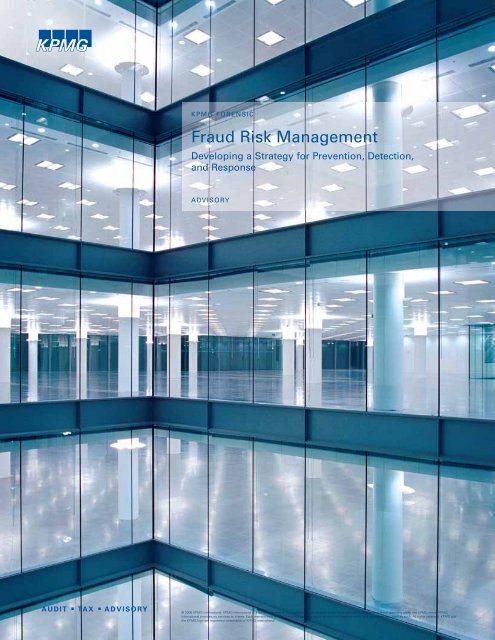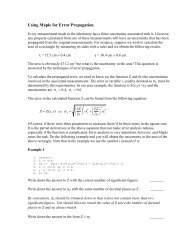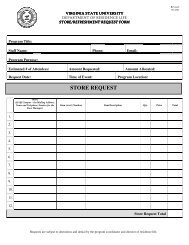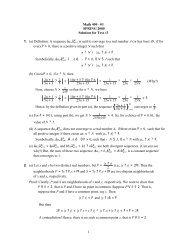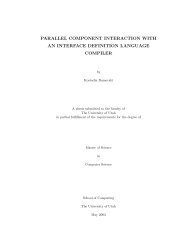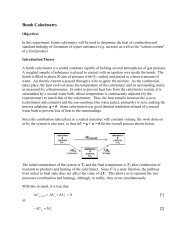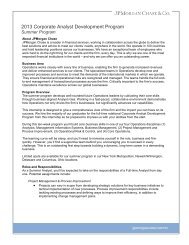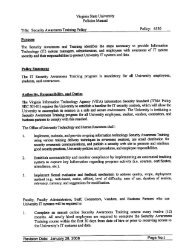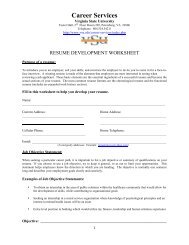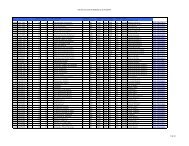Fraud Risk Management - Developing a Strategy for Prevention
Fraud Risk Management - Developing a Strategy for Prevention
Fraud Risk Management - Developing a Strategy for Prevention
- No tags were found...
Create successful ePaper yourself
Turn your PDF publications into a flip-book with our unique Google optimized e-Paper software.
KPMG FORENSIC<strong>Fraud</strong> <strong>Risk</strong> <strong>Management</strong><strong>Developing</strong> a <strong>Strategy</strong> <strong>for</strong> <strong>Prevention</strong>, Detection,and ResponseADVISORY© 2006 KPMG International. KPMG International is a Swiss cooperative that serves as a coordinating entity <strong>for</strong> a network of independent firms operating under the KPMG name. KPMGInternational provides no services to clients. Each member firm of KPMG International is a legally distinct and separate entity and each describes itself as such. All rights reserved. KPMG andthe KPMG logo are registered trademarks of KPMG International.
ContentsForeword 1Executive Summary 2Defining <strong>Fraud</strong> and Misconduct 4Convergence of RegulatoryChallenges 5The Key Objectives: <strong>Prevention</strong>,Detection, Response 6<strong>Prevention</strong> 8Detection 14Response 17An Ongoing Process 20Conclusion 23Appendix: Selected InternationalGovernance and Antifraud Criteria 24© 2006 KPMG International. KPMG International is a Swiss cooperative that serves as a coordinating entity <strong>for</strong> a network of independent firms operating under the KPMG name. KPMGInternational provides no services to clients. Each member firm of KPMG International is a legally distinct and separate entity and each describes itself as such. All rights reserved. KPMG andthe KPMG logo are registered trademarks of KPMG International.
D E V E L O P I N G A S T R A T E G Y F O R P R E V E N T I O N , D E T E C T I O N , A N D R E S P O N S E | 1ForewordInstances of corporate fraud and misconduct remain a constant threat to public trustand confidence in the capital markets. As organizations strive to achieve compliancewith an array of new antifraud laws and regulations that are not prescriptive on thedesign of controls in this area, management’s agenda is focusing on ef<strong>for</strong>ts to:• Understand the fraud and misconduct risks that can undermine their businessobjectives• Determine whether antifraud programs and controls are actually effective inreducing instances of fraud and misconduct• Gain insight on better ways to design and evaluate controls to prevent, detect,and respond appropriately to fraud and misconduct• Reduce exposure to corporate liability, sanctions, and litigation that may arisefrom violations of law or market expectations• Derive practical value from compliance investments by creating a sustainableprocess <strong>for</strong> managing risk and improving per<strong>for</strong>mance• Achieve the highest levels of business integrity through sound corporate governance,internal control, and transparency.This white paper provides an overview of fraud risk management fundamentals,identifies new regulatory mandates from around the world, and spotlights keypractices that organizations have generally found to be effective in the currentenvironment.We hope this perspective provides fresh insights as you consider the risks offraud at home and abroad, and the effectiveness of controls you rely on to mitigatethose risks.Richard H. GirgentiNational Practice LeaderKPMG Forensic SM© 2006 KPMG International. KPMG International is a Swiss cooperative that serves as a coordinating entity <strong>for</strong> a network of independent firms operating under the KPMG name. KPMGInternational provides no services to clients. Each member firm of KPMG International is a legally distinct and separate entity and each describes itself as such. All rights reserved. KPMG andthe KPMG logo are registered trademarks of KPMG International.
2 | F R A U D R I S K M A N A G E M E N TExecutive SummaryIn the wake of high-profile corporate scandals as well as new regulations worldwide,many business leaders are increasingly aware of the need to create company-specificantifraud measures to address internal corporate fraud and misconduct. Whileacknowledging that no single approach to fraud risk management can fit every organization’sneeds, this white paper spotlights key practices that organizations havegenerally found to be effective when tailoring a company-specific antifraud program,and offers a strategic approach to aligning corporate values with per<strong>for</strong>mance.The Business ImperativeAs companies achieve compliance with new antifraud laws and regulations, theiragendas center on management’s ef<strong>for</strong>ts to:• Understand fraud and misconduct risks that can undermine their businessobjectives• Reduce exposure to corporate liability, sanctions, and litigation• Achieve the highest levels of business integrity through sound corporate governance,internal control, and transparency.<strong>Fraud</strong>: Any intentional act committed to secure an unfair or unlawful gain.Misconduct: A broad concept, generally referring to violations of law, regulations,internal policies, and market expectations of ethical business conduct.Convergence of Regulatory ChallengesIn recent years, a variety of laws and regulations have emerged worldwide, providingorganizations with an array of criteria to incorporate into their antifraud ef<strong>for</strong>ts.These laws include:• Australia: The Corporate Law Economic Re<strong>for</strong>m Program (Audit Re<strong>for</strong>m &Corporate Disclosure) Act 2004• Canada: The Canadian Criminal Code• European Union: Financial Services Action Plan (FSAP)• United Kingdom: Companies (Audit, Investigations, and Community Enterprise)Act of 2004• United States: The USA PATRIOT Act, the Foreign Corrupt Practices Act, theSarbanes-Oxley Act of 2002, SAS 99, various NYSE & NASDAQ listing standards,and Public Company Accounting Oversight Board (PCAOB) Standard #2© 2006 KPMG International. KPMG International is a Swiss cooperative that serves as a coordinating entity <strong>for</strong> a network of independent firms operating under the KPMG name. KPMGInternational provides no services to clients. Each member firm of KPMG International is a legally distinct and separate entity and each describes itself as such. All rights reserved. KPMG andthe KPMG logo are registered trademarks of KPMG International.
D E V E L O P I N G A S T R A T E G Y F O R P R E V E N T I O N , D E T E C T I O N , A N D R E S P O N S E | 3The Key Objectives: <strong>Prevention</strong>, Detection, ResponseAn effective, business-driven fraud risk management approach encompassescontrols that have three objectives:• Prevent. Reduce the risk of fraud and misconduct from occurring.• Detect. Discover fraud and misconduct when it occurs.• Respond. Take corrective action and remedy the harm caused by fraud ormisconduct.Pulling It All TogetherThe challenge <strong>for</strong> companies is to develop a comprehensive ef<strong>for</strong>t to:• Understand all of the various control frameworks and criteria that apply to them.• Categorize risk assessments, codes of conduct, and whistleblower mechanismsinto corporate objectives.• Create a broad ranging program that manages and integrates fraud prevention,detection, and response ef<strong>for</strong>ts.An Ongoing ProcessEffective fraud risk management provides an organization with tools to manage riskin a manner consistent with regulatory requirements as well as the entity’s businessneeds and marketplace expectations. Such an approach has four phases:• Assess <strong>Risk</strong>s. Identify the scope of the analysis and key stakeholders, profile thecurrent state of fraud risk management, set targets <strong>for</strong> improvement, and definesteps necessary to close the “gap.”• Design. Develop a broad ranging program that encompasses controls to prevent,detect, and respond to incidents of fraud or misconduct.• Implement. Deploy a strategy and process <strong>for</strong> implementing the new controlsthroughout the organization and assign responsibility <strong>for</strong> leading the overall ef<strong>for</strong>tto a senior individual.• Evaluate. Assess existing controls compared with legal and regulatory frameworksas well as leading practices, such as internal investigation protocols or duediligence practices.© 2006 KPMG International. KPMG International is a Swiss cooperative that serves as a coordinating entity <strong>for</strong> a network of independent firms operating under the KPMG name. KPMGInternational provides no services to clients. Each member firm of KPMG International is a legally distinct and separate entity and each describes itself as such. All rights reserved. KPMG andthe KPMG logo are registered trademarks of KPMG International.
4 | F R A U D R I S K M A N A G E M E N TDefining <strong>Fraud</strong> and Misconduct<strong>Fraud</strong> is a broad legal concept that generally refers to an intentional act committedto secure an unfair or unlawful gain. 1 Misconduct is also a broad concept, generallyreferring to violations of laws, regulations, internal policies, and market expectationsof ethical business conduct. Together, they fall into the following categories of riskthat can undermine public trust and damage a company’s reputation <strong>for</strong> integrity:• <strong>Fraud</strong>ulent financial reporting (e.g., improper revenue recognition, overstatementof assets, understatement of liabilities)• Misappropriation of assets (e.g., embezzlement, payroll fraud, external theft,procurement fraud, royalty fraud, counterfeiting)• Revenue or assets gained by fraudulent or illegal acts (e.g., over-billing customers,deceptive sales practices, accelerated revenue, bogus revenue)• Expenses or liabilities avoided by fraudulent or illegal acts (e.g., tax fraud, wageand hour abuses, falsifying compliance data provided to regulators)• Expenses or liabilities incurred <strong>for</strong> fraudulent or illegal acts (e.g., commercial orpublic bribery, kickbacks)• Other misconduct (e.g., conflicts of interest, insider trading, discrimination, theftof competitor trade secrets, antitrust practices, environmental violations)Scandals and failures, together with flourishing and cynical greed, may haveprofound and prolonged effects on public opinions. It is our collective dutyand well understood interest to demonstrate that market economy goestogether with integrity and common good.Michel PradaChairman of the Autorité des Marchés Financiers French Securities RegulatorsGlobal Public Policy SymposiumOctober 20, 20051Bryan A. Garner, Editor, Black’s Law Dictionary, Eighth Edition, West Group, 2004© 2006 KPMG International. KPMG International is a Swiss cooperative that serves as a coordinating entity <strong>for</strong> a network of independent firms operating under the KPMG name. KPMGInternational provides no services to clients. Each member firm of KPMG International is a legally distinct and separate entity and each describes itself as such. All rights reserved. KPMG andthe KPMG logo are registered trademarks of KPMG International.
D E V E L O P I N G A S T R A T E G Y F O R P R E V E N T I O N , D E T E C T I O N , A N D R E S P O N S E | 5Convergence of RegulatoryChallengesGovernments around the world have responded to corporate scandals and fraudulentactivity by instituting legislative and regulatory re<strong>for</strong>ms aimed at encouragingcompanies to become more self-governing. In recent years, a variety of laws andregulations have emerged, and the timeline in Figure 1 provides a selection ofimportant global regulations and events.Note also that a summary of relevant regulations appears in “Appendix: SelectedInternational Governance and Antifraud Criteria” beginning on page 24.Figure 1: A TimelineCOSO1992CaremarkCase19961980s 1990s 20002001 2002 2003 2004 2005CommonwealthCriminal Code Act1995U.S.SentencingGuidelines1991Financial ServicesAction Plan1999Corporations Act(Including CLERP9 Amendments)2001USA PATRIOT Act2001Sarbanes-OxleyAct of 2002Proceeds ofCrime Act 2002U.S. Departmentof JusticeEn<strong>for</strong>cementGuidance(ThompsonMemo)2003NYSE andNASDAQ ListingStandards2003Revised U.S.SentencingGuidelines2004RevisedCombinedCode withTurnbull,Smith, andHiggsGuidance2005/2006AustraliaEuropean UnionUnited KingdomUnited StatesU.S. Departmentof JusticeEn<strong>for</strong>cementGuidance(Holder Memo)1999The CombinedCode onCorporateGovernance2003The MoneyLaunderingRegulations2003European Councilon Economic<strong>Fraud</strong>2003Source: KPMG LLP (U.S.), 2006Undetected financial fraud is one of the greatest risks to an organization’sviability and corporate reputation, and it has the capacity to draw into itssphere all associated people, not only the guilty.Jeffrey LucyChairman, Australian Securities and Investments CommissionNovember 10, 2005© 2006 KPMG International. KPMG International is a Swiss cooperative that serves as a coordinating entity <strong>for</strong> a network of independent firms operating under the KPMG name. KPMGInternational provides no services to clients. Each member firm of KPMG International is a legally distinct and separate entity and each describes itself as such. All rights reserved. KPMG andthe KPMG logo are registered trademarks of KPMG International.
6 | F R A U D R I S K M A N A G E M E N TThe Key Objectives: <strong>Prevention</strong>,Detection, ResponseAn effective, business-driven fraud and misconduct risk management approach is one<strong>Prevention</strong>Response Detectionthat is focused on three objectives:• <strong>Prevention</strong>: controls designed to reduce the risk of fraud and misconduct fromoccurring in the first place• Detection: controls designed to discover fraud and misconduct when it occurs• Response: controls designed to take corrective action and remedy the harmcaused by fraud or misconductPutting It All TogetherJust as there is an array of fraud and misconduct risks facing a company, there is anarray of control criteria that various regulatory programs require companies to adopt.The challenge <strong>for</strong> companies, there<strong>for</strong>e, is to adopt a comprehensive and integratedapproach that takes all relevant considerations into account and enables them to worktogether. Doing so helps avoid duplicative ef<strong>for</strong>t, resource fragmentation, and “slippagebetween the cracks” associated with a one-off or silo approach.Such an undertaking begins with understanding all of the various control frameworksand criteria that apply to the company (see Figure 2). When this categorization iscomplete, the organization has the in<strong>for</strong>mation it needs to create a comprehensiveprogram in which the elements of prevention, detection, and response can be integratedand managed.Figure 2: Selected International StandardsJurisdictionFrameworkRelevanceAustraliaCorporations Act 2001(including CLERP 9Amendments)Aims to strengthen the financial reportingframework.CanadaThe Multilateral Instrument52-109Promotes an “internal control culture” <strong>for</strong>improving the quality of financial reporting inCanada.NetherlandsCorporate GovernanceCode of Conduct 2004Seeks to improve transparency in shareholderand management relations as well as thestructure and accountability of management inthe Netherlands.<strong>Prevention</strong>United KingdomThe Companies Actof 2004Aims to improve the reliability of financialreporting and the independence of auditors andauditor regulation in the United Kingdom.ResponseDetectionUnited StatesSarbanes-Oxley Actof 2002Introduced substantial changes to the corporategovernance and financial disclosure requirementsof organizations registered with the Securitiesand Exchange Commission and listed on U.S.stock exchanges.Source: KPMG LLP (U.S.), 2006© 2006 KPMG International. KPMG International is a Swiss cooperative that serves as a coordinating entity <strong>for</strong> a network of independent firms operating under the KPMG name. KPMGInternational provides no services to clients. Each member firm of KPMG International is a legally distinct and separate entity and each describes itself as such. All rights reserved. KPMG andthe KPMG logo are registered trademarks of KPMG International.
D E V E L O P I N G A S T R A T E G Y F O R P R E V E N T I O N , D E T E C T I O N , A N D R E S P O N S E | 7Figure 3 lists sample elements of a comprehensive program designed to prevent,detect, and respond to fraud.Figure 3: Sample Antifraud Program Elements<strong>Prevention</strong> Detection ResponseBoard/audit committee oversightExecutive and line management functionsInternal audit, compliance, and monitoring functions• <strong>Fraud</strong> and misconductrisk assessment• Code of conduct andrelated standards• Employee and thirdpartydue diligence• Communication andtraining• Process-specific fraudrisk controls• Hotlines and whistleblowermechanisms• Auditing and monitoring• Proactive <strong>for</strong>ensic dataanalysis• Internal investigationprotocols• En<strong>for</strong>cement andaccountabilityprotocols• Disclosure protocols• Remedial actionprotocolsSource: KPMG LLP (U.S.), 2006The next section spotlights some of the common control elements identified inFigure 3 and offers considerations <strong>for</strong> their design.© 2006 KPMG International. KPMG International is a Swiss cooperative that serves as a coordinating entity <strong>for</strong> a network of independent firms operating under the KPMG name. KPMGInternational provides no services to clients. Each member firm of KPMG International is a legally distinct and separate entity and each describes itself as such. All rights reserved. KPMG andthe KPMG logo are registered trademarks of KPMG International.
8 | F R A U D R I S K M A N A G E M E N T<strong>Prevention</strong>EvaluationAssessment<strong>Prevention</strong>Response DetectionImplementationDesignPreventive controls are designed to help reduce the risk offraud and misconduct from occurring in the first place.Leadership and GovernanceBoard/Audit Committee OversightAn organization’s board of directors plays an important role in the oversight andimplementation of controls to mitigate the risk of fraud and misconduct. The board,together with management, is responsible <strong>for</strong> setting the “tone at the top” andensuring institutional support is established at the highest levels <strong>for</strong> ethical andresponsible business practices.Directors have not only a fiduciary duty to ensure that an organization has programsand controls in place to address the risk of wrongdoing but also a duty to ensurethat such controls are effective. 2As a practical matter, the board may delegate principal oversight <strong>for</strong> fraud and misconductrisk management to a committee (typically audit), which is tasked with, amongother things:• Reviewing and discussing issues raised during the entity’s fraud and misconductrisk assessment• Reviewing and discussing with the internal and external auditors findings on thequality of the organization’s antifraud programs and controls• Establishing procedures <strong>for</strong> the receipt and treatment of questions or concernsregarding questionable accounting or auditing matters. 3A robust fraud strategy is one that is sponsored at the highest level within afirm and embedded within the culture. <strong>Fraud</strong> threats are dynamic and fraudstersconstantly devise new techniques to exploit the easiest target.Philip RobinsonFinancial Crime Sector Leader, Financial Services AuthorityFebruary 27, 20062In re Caremark Int’l Derivative Litig., Del. Ch., 698 A.2d 959 (1996).3A listed company’s audit committee must establish procedures <strong>for</strong> the receipt, retention, and treatment of complaintsregarding accounting, internal accounting controls, or auditing matters, and allow <strong>for</strong> the confidential, anonymous submissionby employees of concerns regarding questionable accounting or auditing matters. See Exchange Act section 10A(m)(4) andSEC Rule 10A-3(b)(3), effective April 2003, which may be found at http://www.sec.gov/rules/final/33-8220.htm.© 2006 KPMG International. KPMG International is a Swiss cooperative that serves as a coordinating entity <strong>for</strong> a network of independent firms operating under the KPMG name. KPMGInternational provides no services to clients. Each member firm of KPMG International is a legally distinct and separate entity and each describes itself as such. All rights reserved. KPMG andthe KPMG logo are registered trademarks of KPMG International.
D E V E L O P I N G A S T R A T E G Y F O R P R E V E N T I O N , D E T E C T I O N , A N D R E S P O N S E | 9Senior <strong>Management</strong> OversightTo help ensure that fraud and misconduct controls remain effective and in line withgovernmental standards, responsibility <strong>for</strong> the organization’s fraud and misconductrisk management approach should be shared at senior levels (i.e., individuals withsubstantial control or a substantial role in policy-making). This critical oversightbegins with prevention and must also be part of detection and response ef<strong>for</strong>ts.The chief executive officer is ideally positioned to influence employee actions throughhis or her executive leadership, specifically by setting the ethical tone of the organizationand playing a crucial role in fostering a culture of high ethics and integrity. Forinstance, the chief executive can lead by example, allocating resources to antifraudef<strong>for</strong>ts and holding senior management accountable <strong>for</strong> compliance violations.Direct responsibility <strong>for</strong> antifraud ef<strong>for</strong>ts should reside with a senior leader, oftena chief compliance officer who works together with internal audit staff and designatedsubject matter experts. The chief compliance officer is responsible <strong>for</strong> coordinatingthe organization’s approach to fraud and misconduct prevention, detection,and response. When fraud and misconduct issues arise, this individual can drawtogether the right resources to deal with the problem and make necessary operationalchanges. The chief compliance officer may also chair a committee of crossfunctionalmanagers who:Achieving good corporate governanceis not solely the responsibilityof the directors, investorsand regulators; it should be acore objective of senior management.Poor corporate governanceweakens a company’spotential and at the worst canpave the way <strong>for</strong> financial difficultiesand even fraud.Bill WitherellDirector <strong>for</strong> Financial andEnterprise AffairsOrganisation <strong>for</strong> EconomicCo-operation and DevelopmentCFO Strategies: CorporateAccountability Forum 2004,May 17, 2004• Coordinate the organization’s risk assessment ef<strong>for</strong>ts• Establish policies and standards of acceptable business practice• Oversee the design and implementation of antifraud programs and controls• Report to the board and/or the audit committee on the results of the organization’sfraud risk management activities.Other business leaders such as department heads (e.g., product development,marketing, regulatory affairs, human resources) should also participate in responsibilitiesunder the organization’s antifraud strategy; they oversee areas of daily operationsin which risks arise. Such department heads can serve as subject matter expertsto assist the chief compliance officer with respect to their particular areas of expertiseor responsibility.© 2006 KPMG International. KPMG International is a Swiss cooperative that serves as a coordinating entity <strong>for</strong> a network of independent firms operating under the KPMG name. KPMGInternational provides no services to clients. Each member firm of KPMG International is a legally distinct and separate entity and each describes itself as such. All rights reserved. KPMG andthe KPMG logo are registered trademarks of KPMG International.
1 0 | F R A U D R I S K M A N A G E M E N TInternal Audit FunctionThe modern organization’s internal audit function is a key participant in antifraud activities,supporting management’s approach to preventing, detecting, and responding tofraud and misconduct. KPMG’s 2003 <strong>Fraud</strong> Survey notes that 65 percent of respondentsindicated that frauds were uncovered through the work of internal audit. Suchresponsibilities represent a change from the more traditional role of internal audit(that is, examining the effectiveness of the entity’s controls). In general, internal auditshould be responsible <strong>for</strong>:• Planning and conducting the evaluation of design and operating effectiveness ofantifraud controls• Assisting in the organization’s fraud risk assessment and helping draw conclusionsas to appropriate mitigation strategies• Reporting to the audit committee on internal control assessments, audits, investigations,and related activities.<strong>Fraud</strong> and Misconduct <strong>Risk</strong> AssessmentAll organizations typically face a variety of fraud and misconduct risks. Like a moreconventional entity-wide risk assessment, a fraud and misconduct risk assessmenthelps management understand the risks that are unique to its business, identifygaps or weaknesses in control to mitigate those risks, and develop a practical plan<strong>for</strong> targeting the right resources and controls to reduce risk.<strong>Management</strong> should ensure that such an assessment is conducted across theentire organization, taking into consideration the entity’s significant business units,processes, and accounts.With input from control owners as to the relevant risks to achieving organizationalobjectives, a fraud and misconduct risk assessment includes the steps listed inFigure 4.Figure 4: <strong>Fraud</strong> <strong>Risk</strong> Assessment ProcessSource: KPMG LLP (U.S.), 2006© 2006 KPMG International. KPMG International is a Swiss cooperative that serves as a coordinating entity <strong>for</strong> a network of independent firms operating under the KPMG name. KPMGInternational provides no services to clients. Each member firm of KPMG International is a legally distinct and separate entity and each describes itself as such. All rights reserved. KPMG andthe KPMG logo are registered trademarks of KPMG International.
D E V E L O P I N G A S T R A T E G Y F O R P R E V E N T I O N , D E T E C T I O N , A N D R E S P O N S E | 1 1While management is responsible <strong>for</strong> per<strong>for</strong>ming a targeted risk assessment processand considering its results in evaluating control effectiveness, the audit committeetypically has an oversight role in this process. The audit committee is responsible <strong>for</strong>reviewing management’s risk assessment, ensuring that it remains an ongoing ef<strong>for</strong>t,and interacting with the entity’s independent auditor to ensure that assessmentresults are properly communicated.Code of ConductAn organization’s code of conduct is oneof the most important communications 52%vehicles that management can use toPercentage of U.S. employeescommunicate to employees on key standardsthat define acceptable business conduct are not taken seriously.who reported that their codes ofconduct. A well-written and communicatedcode goes beyond restating2005 – 2006KPMG Forensic Integrity Surveycompany policies—such a code sets thetone <strong>for</strong> the organization’s overall controlculture, raising awareness of management’s commitment to integrity and theresources available to help employees achieve management’s compliance goals. 4A well-designed code of conduct typically includes:• High-level endorsement from the organization’s leadership, underscoring acommitment to integrity• Simple, concise, and positive language that can be readily understood by allemployees• Topical guidance based on each of the company’s major policies or compliancerisk areas• Practical guidance on risks based on recognizable scenarios or hypotheticalexamples• A visually inviting <strong>for</strong>mat that encourages readership, usage, and understanding• Ethical decision-making tools to assist employees in making the right choices• A designation of reporting channels and viable mechanisms that employees canuse to report concerns or seek advice without fear of retribution.I submit that having a code of ethics that is not vigorously implemented isworse than not having a code of ethics. It smacks of hypocrisy.Roel C. CamposCommissioner, U.S. Securities and Exchange CommissionOctober 16, 20024Both the NYSE and the NASDAQ have adopted corporate governance rules that require U.S.-listed companies to adopt anddisclose codes of conduct <strong>for</strong> directors, officers, and employees, and disclose code waivers <strong>for</strong> directors or executive officers.NYSE Rule 303A(1) may be found at www.nyse.com/about/listed/1101074746736.html, and NASDAQ Rule 4350(n) maybe found at http://nasd.complinet.com/nasd/display/display.html?rbid=1189&element_id=1159000635.© 2006 KPMG International. KPMG International is a Swiss cooperative that serves as a coordinating entity <strong>for</strong> a network of independent firms operating under the KPMG name. KPMGInternational provides no services to clients. Each member firm of KPMG International is a legally distinct and separate entity and each describes itself as such. All rights reserved. KPMG andthe KPMG logo are registered trademarks of KPMG International.
1 2 | F R A U D R I S K M A N A G E M E N TEmployee and Third-Party Due DiligenceAn important part of an effective fraud and misconduct prevention strategy is the useof due diligence in the hiring, retention, and promotion of employees, agents, vendors,and other third parties. Such due diligence may be especially important <strong>for</strong> thoseemployees identified as having authorityover the financial reporting process.The scope and depth of the due diligenceprocess typically varies basedon the organization’s identified risks,the individual’s job function and/or levelof authority, and the specific laws ofthe country in which the organizationresides. 549%Percentage of U.S. employeeswho reported that they wouldbe rewarded based on results,not the means used to achievethem.KPMG Forensic Integrity Survey2005 – 2006There are certain situations wherescreening third parties may be valid. Forexample, management may wish to screen agents, consultants, or temporary workerswho may access confidential in<strong>for</strong>mation or acquisition targets that may haveregulatory or integrity risks that can materially affect the value of the transaction.Due diligence begins at the start of an employment or business relationship andcontinues throughout. For instance, taking into account behavioral considerations—such as adherence to the organization’s core values—in per<strong>for</strong>mance evaluationsprovides a powerful signal that management cares about not only what employeesachieve but also that those achievements were made in a manner consistent withthe company’s values and standards.Communication and TrainingMaking employees aware of their obligationsconcerning fraud and misconductcontrol begins with practical communicationand training. While many organizationscommunicate on such issues inan ad hoc manner, ef<strong>for</strong>ts taken withoutplanning and prioritization may fail toprovide employees with a clear messagethat their control responsibilities are tobe taken seriously.55%Percentage of U.S. employeeswho reported that they lackedunderstanding of the standardsof conduct that apply to theirjobs.KPMG Forensic Integrity Survey2005 – 20065One of the minimum requirements announced by the sentencing guidelines <strong>for</strong> organizational defendants calls <strong>for</strong> the organizationto use reasonable ef<strong>for</strong>ts and exercise due diligence to exclude individuals from positions of substantial authority whohave engaged in illegal activities. See United States Sentencing Commission, Guidelines Manual, §8B2.1(b)(3) (Nov. 2004)available at http://www.ussc.gov/2005guid/CHAP8.pdf.© 2006 KPMG International. KPMG International is a Swiss cooperative that serves as a coordinating entity <strong>for</strong> a network of independent firms operating under the KPMG name. KPMGInternational provides no services to clients. Each member firm of KPMG International is a legally distinct and separate entity and each describes itself as such. All rights reserved. KPMG andthe KPMG logo are registered trademarks of KPMG International.
D E V E L O P I N G A S T R A T E G Y F O R P R E V E N T I O N , D E T E C T I O N , A N D R E S P O N S E | 1 3In <strong>for</strong>mulating a training and communications plan, management should considerdeveloping fraud and misconduct awareness initiatives that are:• Comprehensive and based upon job functions and risk areas• Integrated with other training ef<strong>for</strong>ts, whenever possible• Effective in a variety of settings, using multiple methods and techniques• Regular and frequent, covering the relevant employee population.Senior management must move from thinking about compliance as chieflya cost center to considering the benefits of compliance in protectingagainst the legal and reputational risks that can have an impact on thebottom line.Susan Schmidt BiesU.S. Federal Reserve Board GovernorThe Bank Administration Institute’s Fiduciary <strong>Risk</strong> <strong>Management</strong> Conference 2004Current Issues in Corporate GovernanceApril 26, 2004© 2006 KPMG International. KPMG International is a Swiss cooperative that serves as a coordinating entity <strong>for</strong> a network of independent firms operating under the KPMG name. KPMGInternational provides no services to clients. Each member firm of KPMG International is a legally distinct and separate entity and each describes itself as such. All rights reserved. KPMG andthe KPMG logo are registered trademarks of KPMG International.
1 4 | F R A U D R I S K M A N A G E M E N TDetectionAssessmentDetective controls are designed to uncover fraud and misconductwhen it occurs.Evaluation<strong>Prevention</strong>Response DetectionDesignMechanisms <strong>for</strong> Seeking Advice and Reporting MisconductWith the oversight and guidance of senior management, organizations tend toprovide employees with multiple channels <strong>for</strong> reporting concerns about fraud orImplementationmisconduct. Many typically request that employees follow a process that wouldbegin with alerting their own managers, if possible, or a designated humanresources or compliance officer. Telephone “hotlines” are often made available andcan be used at any time, although they are usually intended <strong>for</strong> use when thenormal channels are impractical or ineffective. A hotline typically provides a viablemethod whereby employees, and other third-parties if applicable, are encouraged to:• Communicate concerns about potential fraud and misconduct, including questionableaccounting or auditing matters• Seek advice be<strong>for</strong>e making decisions when the appropriate course of action isunclear.A well-designed hotline typically includes the following features:• Confidentiality. All matters reported via the hotline are treated confidentially.Hotline operators in<strong>for</strong>m callers that their concerns will be reported only on a“need to know” basis and that relevant safeguards are in place to ensure thatsuch confidentiality is maintained. Hotline operators notify callers if the confidentialityof the matter is subject to any legislative limitations.• Anonymity. The organization’s protocols allow <strong>for</strong> the anonymous submission andresolution of calls. For instance, callers who wish to remain anonymous are givena case tracking number that they can later use to provide additional details relatedto their question or allegation and/or check the status or outcome of their call.• Organization-wide Availability. Employees at international locations are ableto use the hotline through features such as real-time interpreting and toll-freecall routing.• “Real Time” Assistance. The hotline is designed to provide an immediate, “live”response to a call to facilitate thorough and consistent treatment of a caller’squestion or concern as well as to provide immediate guidance. Thus, hotline operatorsneed to be appropriately qualified, trained, and, in some situations, authorizedto provide advice.• Data <strong>Management</strong> Procedures. The hotline operator uses consistent protocols<strong>for</strong> gathering relevant facts and managing the hotline calls.• Classification of Financial Reporting Concerns. The hotline includes protocolswhereby qualified individuals (e.g., internal audit, legal, security) can determinewhether the nature of an allegation could trigger a financial reporting risk.© 2006 KPMG International. KPMG International is a Swiss cooperative that serves as a coordinating entity <strong>for</strong> a network of independent firms operating under the KPMG name. KPMGInternational provides no services to clients. Each member firm of KPMG International is a legally distinct and separate entity and each describes itself as such. All rights reserved. KPMG andthe KPMG logo are registered trademarks of KPMG International.
D E V E L O P I N G A S T R A T E G Y F O R P R E V E N T I O N , D E T E C T I O N , A N D R E S P O N S E | 1 5• Audit Committee Notification. The hotline includes protocols that specify thenature and timing of allegations that are escalated to the audit committee.• Follow-up on Non-retaliation. The organization’s protocols allow <strong>for</strong> following upwith employees periodically after the hotline case has been closed (e.g., at one-,three-, and six-month intervals) to ensure that reporting employees have not experiencedretaliation. The company encourages the employees to report anyinstances of retaliation and takes swift action against those who do retaliate.• Prominent Communications. The organization publicizes its hotline prominently.Such communications may include, among others, (1) describing the hotlinewithin the code of conduct and other key company publications and training; (2)displaying the hotline telephone number on posters, banners, wallet cards, screensavers, telephone directories, or desk calendars; and (3) communicating minicase-studiesbased on hotline calls to employees (e.g., in newsletters, trainingprograms, or intranet sites) to demonstrate that the organization values hotlinecalls and is able to provide assistance to those who use the hotline.Auditing and MonitoringAuditing and monitoring systems that are reasonably designed to detect fraud andmisconduct are important tools that management can use to determine whetherthe organization’s controls are workingas intended. Since it is impossible toaudit every fraud and misconduct risk,33%management should develop a comprehensiveauditing and monitoring plan Percentage of Australia/Newthat is based on risks identified through Zealand employees reportingthe organization’s fraud risk assessmentprocess.that early warnings of fraudproblems were ignored.KPMG <strong>Fraud</strong> Survey 2004An auditing and monitoring plan shouldthus encompass activities that aretailored in depth to the nature and degree of the risk involved, with higher-risk issuesreceiving priority treatment. Auditing activities (an evaluation of past events) andmonitoring activities (an evaluation conducted real-time) should be per<strong>for</strong>med in, butare not limited to, areas where:• There are specific concerns about a key procedure, account, or position• The company has a history of fraud and misconduct• There is high employee turnover or organizational change• Laws and regulations have changed significantly• Audits are legally required, or governmental agencies are targeting en<strong>for</strong>cementactions.© 2006 KPMG International. KPMG International is a Swiss cooperative that serves as a coordinating entity <strong>for</strong> a network of independent firms operating under the KPMG name. KPMGInternational provides no services to clients. Each member firm of KPMG International is a legally distinct and separate entity and each describes itself as such. All rights reserved. KPMG andthe KPMG logo are registered trademarks of KPMG International.
1 6 | F R A U D R I S K M A N A G E M E N TAn organization’s managers involved in auditing and monitoring ef<strong>for</strong>ts should notonly have sufficient training and experience but also be seen as objective in evaluatingthe controls <strong>for</strong> which they are responsible. Optimally, auditing and monitoringprotocols should:• Occur in the ordinary course of operations, including during regular managementand supervisory activities• Draw on external in<strong>for</strong>mation to corroborate internally generated in<strong>for</strong>mation• Formally communicate identified deficiencies and exceptions to the organization’ssenior leadership, so that the harm to the organization is appropriately understoodand mitigated• Use results to enhance and modify other controls, such as communications andtraining, per<strong>for</strong>mance evaluations, and discipline.Proactive Data AnalysisMany of the indicators of fraud andmisconduct, both actual and potential,reside within an organization’s financial,operational, and transactional data, and canbe identified using data analysis tools andtechniques. Such proactive data analysisuses sophisticated analytical tests,computer-based cross matching, and nonobviousrelationship identification to highlightpotential fraud and misconduct thatcan remain unnoticed by management,often <strong>for</strong> years. The benefits of such ananalysis may include, among others:• Identification of hidden relationshipsbetween people, organizations, andevents• A means to analyze suspicioustransactions• An ability to assess the effectivenessof internal controls intended to preventor detect fraudulent activities• The potential to continually monitorfraud threats and vulnerabilities• The ability to consider and analyze thousandsof transactions in less time, moreefficiently, and cost-effectively thanusing more traditional <strong>for</strong>ensic samplingtechniques• The ability to consider a company’sunique organizational and industry issues.Transactions can be analyzed using eitherretrospective or continuous transactionmonitoring. Retrospective analyses alloworganizations to analyze transactions in oneortwo-year increments, enabling organizationsto discern patterns that are not visiblewith shorter-term analyses. Creating thecapability to per<strong>for</strong>m retrospective-basedproactive <strong>for</strong>ensic data analysis includessteps to:• Assess the fraud risk profile of systemsor processes• Define the overall objectives of theanalysis• Create a methodology to acquire, extract,and evaluate the data• Define the analyses to be per<strong>for</strong>med• Select software tools to be used inper<strong>for</strong>ming the analysis• Per<strong>for</strong>m the analysis, aggregate andprioritize the results, and review andresolve the exceptions identified.Unlike retrospective-based analyses,continuous transaction monitoring allowsan organization to identify potentially fraudulenttransactions on, <strong>for</strong> example, a daily,weekly, or monthly basis. Organizationsfrequently use continuous monitoring ef<strong>for</strong>tsto focus on narrow bands of transactions orareas that pose particularly strong risks.© 2006 KPMG International. KPMG International is a Swiss cooperative that serves as a coordinating entity <strong>for</strong> a network of independent firms operating under the KPMG name. KPMGInternational provides no services to clients. Each member firm of KPMG International is a legally distinct and separate entity and each describes itself as such. All rights reserved. KPMG andthe KPMG logo are registered trademarks of KPMG International.
D E V E L O P I N G A S T R A T E G Y F O R P R E V E N T I O N , D E T E C T I O N , A N D R E S P O N S E | 1 7ResponseAssessmentResponse controls are designed to take corrective action andremedy the harm caused by fraud or misconduct.Evaluation<strong>Prevention</strong>Response DetectionImplementationDesignInvestigationsWhen in<strong>for</strong>mation relating to actual or potential fraud and misconduct is uncovered,management should be prepared to conduct a comprehensive and objective internalinvestigation. The purpose of such an investigation is to gather facts leading to a credibleassessment of the suspected violation, so management can decide on a soundcourse of action.By conducting an effective internal investigation, management can address a potentiallytroublesome situation and have an opportunity to avert a potentially intrusivegovernment investigation. A well-designed investigative process will typically includethe following attributes, among others:• Oversight by the organization’s audit committee, or a special committee of theboard, either of which must comprise independent directors who are able to wardoff undue pressure or interference from management• Direction by outside counsel, selected by the audit committee, with little or no tiesto the entity’s management team, and that can per<strong>for</strong>m an unbiased, independent,and qualified investigation• Vetting by the organization’s external auditor so that the latter can rely on theproposed scope of work in the audit of the organization’s financial statements• A full-cooperation requirement, allowing no employee or member of managementto obscure the facts that gave rise to the investigation• Reporting protocols, providing the external auditors, regulators, and, where appropriate,the public with in<strong>for</strong>mation relevant to the investigation’s findings in a spiritof cooperation and transparency.Based on a number of factors, including the nature of the potential illegal act, partiesinvolved, and materiality, the organization may decide to use one or more of theabove steps. <strong>Management</strong> would consult with the appropriate oversight functionsand internal protocols to determine the steps that best address the allegation.En<strong>for</strong>cement and AccountabilityA consistent and credible disciplinarysystem is a key control that can beeffective in deterring fraud and misconduct.Appropriate discipline is, additionally,a requirement under leadingregulatory frameworks. By mandatingmeaningful sanctions, management cansend a signal to both internal and externalparties that the organization considersmanaging fraud and misconduct riska top priority.47%Percentage of U.S. employeeswho reported that wrongdoerswould be disciplined fairlyregardless of their position.KPMG Forensic Integrity Survey2005 – 2006© 2006 KPMG International. KPMG International is a Swiss cooperative that serves as a coordinating entity <strong>for</strong> a network of independent firms operating under the KPMG name. KPMGInternational provides no services to clients. Each member firm of KPMG International is a legally distinct and separate entity and each describes itself as such. All rights reserved. KPMG andthe KPMG logo are registered trademarks of KPMG International.
1 8 | F R A U D R I S K M A N A G E M E N TA well-designed disciplinary process will be communicated to all employees andinclude company-wide guidelines that promote:• Progressive sanctions consistent with the nature and seriousness of the offense(e.g., verbal warning, written warning, suspension, pay reduction, location transfer,demotion, or termination)• Uni<strong>for</strong>m and consistent application of discipline regardless of rank, tenure, orjob function.Holding managers accountable <strong>for</strong> the misconduct of their subordinates is anotherimportant consideration. Managers may be disciplined in those instances wherethey knew, or should have known, that fraud and misconduct might be occurring,or when they:• Directed or pressured others to violate company standards to meet businessobjectives or set unrealistic goals that had the same effect• Failed to ensure employees received adequate training or resources• Failed to set a positive example of acting with integrity or had a prior history ofmissing or permitting violations• En<strong>for</strong>ced company standards inconsistently or retaliated against others <strong>for</strong> reportingconcerns.Corrective ActionOnce fraud and misconduct has occurred, management should consider taking actionto remedy the harm caused. For example, management may wish to consider takingthe following steps, among others, where appropriate:• Voluntarily disclosing the results ofthe investigation to the government orother relevant body (i.e., a regulator)• Remedying the harm caused 63%• Examining the root causes of the relevantcontrol breakdowns, ensuringPercentage of Australian/NewZealand organizations thatthat risk is mitigated and that controls reported the incident to theare strengthenedpolice.• Administering discipline to thoseKPMG <strong>Fraud</strong> Survey 2004involved in the inappropriate actionsas well as to those in managementpositions who failed to prevent or detect such events• Communicating to the wider employee population that management took appropriate,responsive action.Although public disclosure of fraud and misconduct may be embarrassing to an organization,management may nonetheless wish to consider such an action in order tocombat or preempt negative publicity, demonstrate good faith, and assist in puttingthe matter to rest.© 2006 KPMG International. KPMG International is a Swiss cooperative that serves as a coordinating entity <strong>for</strong> a network of independent firms operating under the KPMG name. KPMGInternational provides no services to clients. Each member firm of KPMG International is a legally distinct and separate entity and each describes itself as such. All rights reserved. KPMG andthe KPMG logo are registered trademarks of KPMG International.
D E V E L O P I N G A S T R A T E G Y F O R P R E V E N T I O N , D E T E C T I O N , A N D R E S P O N S E | 1 9To Charge or Not to Charge?In deciding not to charge Seabord Corporation with violations of the federal securitieslaws following an investigation of alleged accounting irregularities, the SEC announcedinfluential dictum that a company’s self-policing, self-reporting, remediation, and cooperationwith law en<strong>for</strong>cement authorities, while no guarantee <strong>for</strong> leniency, would factor intothe prosecutorial decision-making process. Among other questions the SEC would beasking the following:• Did the company promptly, completely, and effectively disclose the existence of themisconduct to the public, to regulators, and to self-regulators?• Did the company cooperate completely with appropriate regulatory and law en<strong>for</strong>cementbodies?• Did the company appropriately recompense those adversely affected by the conduct?• Did it do a thorough review of the nature, extent, origins, and consequences of theconduct and related behavior?• Did the company promptly make available to our staff the results of its review andprovide sufficient documentation reflecting its response to the situation?• Did the company voluntarily disclose in<strong>for</strong>mation our staff did not directly request andotherwise might not have uncovered?• Did the company ask its employees to cooperate with our staff and make all reasonableef<strong>for</strong>ts to secure such cooperation?Accounting and Auditing En<strong>for</strong>cement, Exchange Act Release No. 44,969 (October 23,2001). The release may be found at www.sec.gov/litigation/investreport/34-44969.htm.To Fine or Not to Fine?In a related opinion on January 4, 2006, the SEC opined that in deciding the appropriatenessof a civil monetary penalty levied against a corporate settlement of action, the followingfactors would be examined:• The presence or absence of a direct benefit to the corporation as a result of theviolation.• The degree to which the penalty will recompense or further harm the injured shareholders.• The need to deter the particular type of offense.• The extent of the injury to innocent parties.• Whether complicity in the violation is widespread throughout the corporation.• The level of intent on the part of the perpetrators.• The degree of difficulty in detecting the particular type of offense.• Presence or lack of remedial steps by the corporation.• Extent of cooperation with Commission and other law en<strong>for</strong>cement.Statement of the Securities and Exchange Commission Concerning Financial Penalties,Release 2006-4 (January 4, 2006). The Statement may be found at http://www.sec.gov/news/press/2006-4.htm.© 2006 KPMG International. KPMG International is a Swiss cooperative that serves as a coordinating entity <strong>for</strong> a network of independent firms operating under the KPMG name. KPMGInternational provides no services to clients. Each member firm of KPMG International is a legally distinct and separate entity and each describes itself as such. All rights reserved. KPMG andthe KPMG logo are registered trademarks of KPMG International.
2 0 | F R A U D R I S K M A N A G E M E N TAn Ongoing ProcessAn effective fraud risk management approach provides an organization with tools toAssessmenthelp manage risk in a manner consistent with regulatory requirements as well as theEvaluation<strong>Prevention</strong>Response DetectionDesignentity’s business needs and marketplace expectations. As described below, developingsuch an approach can be achieved in key phases:• Assessment of <strong>Risk</strong>s. Assessing the needs of the organization based on thenature of fraud and misconduct that risk controls are intended to mitigate andImplementationthe adequacy of existing controls.• Design. <strong>Developing</strong> controls to prevent, detect, and respond to identified risks ina manner consistent with legal and regulatory criteria and other leading practices.• Implementation. Deploying a process <strong>for</strong> implementing the new controls andassigning responsibility to individuals with the requisite level of authority, objectivity,and resources to support the process.• Evaluation. Evaluating the design and operating effectiveness of controls throughcontrol self-assessment, substantive testing, routine monitoring, and separateevaluations.AssessmentThe nature of fraud and misconduct risks facing an organization can be as diverseand fluid as the business itself. The risks of fraud and misconduct <strong>for</strong> a national bankthat has experienced rapid growth through acquisitions are different than those of aglobal energy company seeking to expand crude exploration in emerging markets.There<strong>for</strong>e, antifraud measures should be tailored to the unique risks of an organization,the specific conditions that give rise to those risks, and the targeted resourceneeds required in balancing risk and control.The first step is to determine what a company’s fraud risks are and how effectivelythe organization manages these risks. To get started, an organization would considerwhich business units, processes, systems, and controls, among other factors, mayneed to be included in the scope of the analysis. The organization can also identifykey stakeholders who may need to be involved. Once the organization profiles itscurrent state and sets targets <strong>for</strong> improvements, it can assess the “gap” it mustclose to reach the desired state and begin defining the necessary steps to get there.DesignThe goal of the control design phase is <strong>for</strong> management to develop controls that willoperate effectively and protect the organization from the risk of fraud and misconduct.However, <strong>for</strong> an entity to design effective controls, it must first tailor these controlsto the risks it is facing as well as the organization’s unique business environment.© 2006 KPMG International. KPMG International is a Swiss cooperative that serves as a coordinating entity <strong>for</strong> a network of independent firms operating under the KPMG name. KPMGInternational provides no services to clients. Each member firm of KPMG International is a legally distinct and separate entity and each describes itself as such. All rights reserved. KPMG andthe KPMG logo are registered trademarks of KPMG International.
D E V E L O P I N G A S T R A T E G Y F O R P R E V E N T I O N , D E T E C T I O N , A N D R E S P O N S E | 2 1When designing controls, management should endeavor to do more than observeregulatory requirements (i.e., minimum criteria defined by various regulatory frameworks).Rather, management should take into account the relevance of a variety ofleading practices (i.e., practices that similarly situated organizations have generallyfound to be effective). Incorporating leading practices into the design of fraud controlsincreases the likelihood that those controls will ultimately prove to be effective.Each entity is unique and thus will have individualized control considerations.<strong>Management</strong> would be well served to consider the organization’s unique circumstanceswhen designing fraud controls. Control attributes that may be appropriate<strong>for</strong> a global telecommunications company may be inappropriate <strong>for</strong> a national bank,and vice versa. <strong>Management</strong> should seek to design controls that satisfy not onlylegal requirements but also the organization’s distinct business needs.ImplementationOnce fraud controls have been designed, management should establish a strategyand process <strong>for</strong> implementing the new controls throughout the organization andassign to a senior individual responsibility and resources <strong>for</strong> leading the overallef<strong>for</strong>t. Meaningful and consistent implementation typically requires a substantialchange in workplace culture and practices. There<strong>for</strong>e, employees should receiveclear and frequent communications with respect to when, how, and by whom thecontrols will be rolled out as well as the manner with which compliance with thenew controls will be en<strong>for</strong>ced.EvaluationSimply because a control exists is no guarantee that it is operating as intended. Aftera control has been operating <strong>for</strong> a designated period of time, it should be evaluatedto determine whether it was designed and implemented to achieve optimal effectiveness.Such an evaluation should first consider those controls identified as “higherrisk” be<strong>for</strong>e other, lower-priority controls.On the other hand, simply because a particular control does not yet exist, managementshould not automatically conclude that the organization’s risk managementobjective is not being met. In the absence of a specific control, other compensatingcontrols may be operating effectively and mitigating the risk of fraud and misconduct.When evaluating the design effectiveness of a control, management should takeinto account both regulatory requirements and leading practices that similarly situatedorganizations have found to correlate with effective risk mitigation. <strong>Management</strong>can then use a “gap analysis” process to determine whether the control in question© 2006 KPMG International. KPMG International is a Swiss cooperative that serves as a coordinating entity <strong>for</strong> a network of independent firms operating under the KPMG name. KPMGInternational provides no services to clients. Each member firm of KPMG International is a legally distinct and separate entity and each describes itself as such. All rights reserved. KPMG andthe KPMG logo are registered trademarks of KPMG International.
2 2 | F R A U D R I S K M A N A G E M E N Tindeed incorporates the required design criteria. For instance, where a design criteriacalls <strong>for</strong> the organization’s whistleblower hotline to allow anonymous submissionof questions or concerns regarding accounting and auditing matters, managementshould seek to determine whether the hotline protocols indeed allow <strong>for</strong> calleranonymity.To evaluate the operational effectiveness of a particular control, management shouldfocus on the extent to which the control’s objectives have been achieved. For example,have the mitigation strategies identified during the fraud and misconduct riskassessment been implemented properly? Similarly, management may have put inplace a well-designed code of conduct, but are employees actually using the code toguide their day-to-day activities? In the end, the integrity climate will determine theperceptions employees have of the ability of the organization to prevent, detect, andrespond to fraud and misconduct and base their own conduct on those perceptions.Only when such basic questions are addressed can management focus on gatheringempirical data on control effectiveness using review and evaluation techniques (e.g.,proactive <strong>for</strong>ensic data analysis). For instance, management may wish to ascertainwhether employees truly understand the standards contained in the code of conductor whether employees feel com<strong>for</strong>table calling the hotline. To gather such hard-toauditqualitative data, management may wish to field a survey of employee perceptionsand attitudes. Such a survey can be a powerful tool, generating data that canbe benchmarked against prior-year results to note improvements and demonstratecontrol effectiveness.An organization’s particular situation should be taken into account in conducting aneffectiveness evaluation, and such an inquiry should remain ongoing. <strong>Management</strong>should continuously consider how its risk strategy and control effectiveness areaffected by changes in market expectations, external scrutiny, and regulatory orlegislative developments.© 2006 KPMG International. KPMG International is a Swiss cooperative that serves as a coordinating entity <strong>for</strong> a network of independent firms operating under the KPMG name. KPMGInternational provides no services to clients. Each member firm of KPMG International is a legally distinct and separate entity and each describes itself as such. All rights reserved. KPMG andthe KPMG logo are registered trademarks of KPMG International.
D E V E L O P I N G A S T R A T E G Y F O R P R E V E N T I O N , D E T E C T I O N , A N D R E S P O N S E | 2 3ConclusionFaced with an increasing array of rules and standards governing business conduct,many organizations worldwide continue to struggle with how to mitigate the innumerablerisks posed by fraud and misconduct.The development of a broad ranging fraud risk management program is an importantstep in managing this challenge. Organizations undertaking the ef<strong>for</strong>t shouldbegin by assessing how well they are managing fraud risk. Identifying known risksand existing controls is an important first step. Then the organization can determineits ideal future state, per<strong>for</strong>m a gap analysis, and prioritize activities that will helpenable the development of a company-specific antifraud program.Such a program will not only help enable appropriate compliance with regulatorymandates but also help the organization align its corporate values and per<strong>for</strong>manceas well as protect its many assets, including its reputation.© 2006 KPMG International. KPMG International is a Swiss cooperative that serves as a coordinating entity <strong>for</strong> a network of independent firms operating under the KPMG name. KPMGInternational provides no services to clients. Each member firm of KPMG International is a legally distinct and separate entity and each describes itself as such. All rights reserved. KPMG andthe KPMG logo are registered trademarks of KPMG International.
2 4 | F R A U D R I S K M A N A G E M E N TAppendix: Selected InternationalGovernance and Antifraud CriteriaAustraliaCommonwealth Criminal Code Act (1995)Boards have a responsibility to foster a culture of compliance with Australian law.Under the Criminal Code, a company can be convicted of Commonwealth criminaloffenses if it is established that the company had a culture that directed or encouraged,tolerated, or led to noncompliance, or that the body failed to maintain a culturethat required compliance with relevant legislation. (Schedule, Part 2.5, Division 12)Corporations Act 2001 (Including CLERP 9 Amendments) (2001)Directors must exercise their powers and discharge their duties with care and diligence.(Section 180)CEO and CFO of a listed entity must make a declaration that:• An entity’s financial records must be properly maintained in accordance withthe Act.• Financial statements <strong>for</strong> the financial year must comply with the accountingstandards.• Financial statements must present a true and fair view of the financial positionand per<strong>for</strong>mance of the entity. (Section 295A)AUS 210 (2002)Establishes a requirement <strong>for</strong> auditors to consider fraud and error in an audit of afinancial report. (AUS 210)Australian Stock Exchange Guidance Note 9A (2003)Requires the board or appropriate board committee to establish policies on risk oversightand management. (Principle 7)Australian Standard 8001 – 2003 <strong>Fraud</strong> and Corruption Control (2003)Provides guidance on fraud and corruption control that is considered best practice.European UnionThe Financial Services Action Plan (FSAP) (1999)The FSAP is designed to create a single market in financial services throughout theEU. Forty-two legislative measures were contemplated as part of the action plan,many of which focused on securities regulation. As of 2004, these measures arehaving a tremendous effect on the regulation of EU capital markets and, as with theSarbanes-Oxley Act, have necessitated major adjustments on the part of issuers,accountants and lawyers, and regulators affected by the legislation.Third Directive on the <strong>Prevention</strong> of the Use of the Financial System <strong>for</strong> MoneyLaundering or Terrorist Financing (2005/60/EC)Council Directive 2005/60/EC is an update to two earlier directives in response toconcerns about money laundering. This Directive requires member states to:• Fight against money laundering• Compel the financial sector, including credit institutions, to take various measuresto establish customers’ identities© 2006 KPMG International. KPMG International is a Swiss cooperative that serves as a coordinating entity <strong>for</strong> a network of independent firms operating under the KPMG name. KPMGInternational provides no services to clients. Each member firm of KPMG International is a legally distinct and separate entity and each describes itself as such. All rights reserved. KPMG andthe KPMG logo are registered trademarks of KPMG International.
D E V E L O P I N G A S T R A T E G Y F O R P R E V E N T I O N , D E T E C T I O N , A N D R E S P O N S E | 2 5• Urge the financial sector to keep appropriate records• Establish internal procedures to train staff to report suspicions to the authoritiesand to set up preventive systems within their organizations.This Directive also introduces additional requirements and safeguards <strong>for</strong> situationsof higher risk (e.g., trading with correspondent banks situated outside the EU).United KingdomThe Financial Services and Markets Act (2000)This Act supports the Financial Services Authority’s (FSA’s) goal to reduce the likelihoodthat business carried on by a regulated person, or in contravention of thegeneral prohibition, can be used <strong>for</strong> a purpose connected with financial crime. As aresult, the FSA requires senior management of regulated firms to take responsibility<strong>for</strong> managing fraud risks, and firms to have effective systems and controls in placeproportionate to the particular financial crime risks that they face.Proceeds of Crime Act (2002)The Act has strengthened the law on money laundering and sets up an AssetsRecovery Agency to investigate and recover assets and wealth obtained as a resultof unlawful activity.Combined Code on Corporate Governance (2003)The Financial Reporting Council’s (FRC) Combined Code on Corporate Governancesets out standards of good practice in relation to issues such as board compositionand development, remuneration, accountability and audit, and relations with shareholders.All companies incorporated in the United Kingdom and listed on the LondonStock Exchange are required under the Listing Rules to report on how they haveapplied the Combined Code in their annual report and accounts, or—where theyhave not—to provide an explanation.The current version of the Combined Code was published in July 2003. In recentyears, related guidance has been issued including the Turnbull guidance on InternalControl, revised in October 2005; the Smith guidance on Audit Committees; and theHiggs guidance on good practices.An implementation review carried out by the FRC in 2005 indicated the Code is havinga favorable impact on the quality of corporate governance. The results also turned upno appetite <strong>for</strong> major change, and only two suggested amendments carried strongsupport. The FRC began consulting on these amendments in January 2006. The mainproposals would be to relax the existing provisions to allow the chairman to sit on theremuneration committee and to add a new provision regarding companies including a“vote withheld” box on the annual general meeting (AGM) proxy voting <strong>for</strong>ms, asrecommended by the Shareholder Voting Working Group. Consultation on possibleamendments to the Code closed on April 21, 2006. If implemented, the intention isthat changes would apply to financial years beginning on or after November 1, 2006.© 2006 KPMG International. KPMG International is a Swiss cooperative that serves as a coordinating entity <strong>for</strong> a network of independent firms operating under the KPMG name. KPMGInternational provides no services to clients. Each member firm of KPMG International is a legally distinct and separate entity and each describes itself as such. All rights reserved. KPMG andthe KPMG logo are registered trademarks of KPMG International.
2 6 | F R A U D R I S K M A N A G E M E N TThe Money Laundering Regulations (2003)In the United Kingdom, these regulations require various kinds of businesses toidentify their customers under specific circumstances and to retain copies of identificationevidence <strong>for</strong> five years. These regulations apply to banks, check cashingbusinesses, money transmitters, accountants, solicitors, casinos, estate agents,bureaus de change, and dealers in high-value goods. Employers may be prosecuted<strong>for</strong> a breach of these regulations if they fail to train staff.United StatesDirector and Officer Liability (August 1996)The Delaware Chancery Court in In re Caremark Int’l Inc. Derivative Litigation heldthat boards of directors that exercise reasonable oversight of a compliance programmay be eligible <strong>for</strong> protection from personal liability in shareholder civil suits resultingfrom employee misconduct. A director’s fiduciary duty goes beyond ensuringthat a compliance program exists, but also includes a good faith duty to ensure thatthe organization’s compliance program is adequate.Department of Justice Prosecution Policy (Original June 1999, revised January 2003)The Department of Justice’s guidance (the Thompson Memo) instructs federal prosecutorsthat while having in place a compliance program does not absolve a corporationfrom criminal liability, it may provide factors that can be used in determiningwhether to charge an organization or only its employees and agents with a crime.These factors include evaluating whether:• The compliance program is merely a “paper program” or is designed and implementedeffectively• Corporate management is en<strong>for</strong>cing the program or tacitly encouraging or pressuringemployees to engage in misconduct to achieve business objectives• The corporation has sufficient staff to audit and evaluate results of its complianceef<strong>for</strong>ts• Employees are in<strong>for</strong>med about the program and are convinced of the corporation’scommitment to it.Sarbanes-Oxley Act of 2002The U.S. government had responded to widespread cases of corporate fraud andmisconduct by passing the Sarbanes-Oxley Act of 2002. The Act includes the followingsections, among others:• Section 301: Requires audit committees to establish procedures to receive, retain,and treat complaints from employees and others about accounting, internalaccounting controls, or auditing matters.• Section 404: <strong>Management</strong> and external auditors are to evaluate the effectivenessof a company’s internal control over financial reporting based on a suitable controlframework.• Section 406: Instructs the SEC to issue rules requiring companies to either adopta code of ethics applicable to senior financial officers or disclose why they do not.© 2006 KPMG International. KPMG International is a Swiss cooperative that serves as a coordinating entity <strong>for</strong> a network of independent firms operating under the KPMG name. KPMGInternational provides no services to clients. Each member firm of KPMG International is a legally distinct and separate entity and each describes itself as such. All rights reserved. KPMG andthe KPMG logo are registered trademarks of KPMG International.
D E V E L O P I N G A S T R A T E G Y F O R P R E V E N T I O N , D E T E C T I O N , A N D R E S P O N S E | 2 7• Section 806: Requires all companies regulated by the SEC to have in place amechanism whereby a whistleblower could report a violation of law or SEC rule,and to protect from retaliation any person who uses that mechanism.• Section 1107: Provides penalties and/or fines <strong>for</strong> retaliating against any corporatewhistleblower, amending section 1513 of Title 18, United States Code.Most companies in the United States are applying the integrated internal controlframework developed by the Committee of Sponsoring Organizations (COSO) of theTreadway Commission <strong>for</strong> this purpose. Generally speaking, COSO addresses ethicsand compliance program elements in company-level components that have a pervasiveinfluence on organizational behavior, such as the control environment. Examplesof company-level control considerations include:• Establishment of the tone at the top by the board and management• Existence of codes of conduct and other policies regarding acceptable businesspractices• Extent to which employees are made aware of management’s expectations• Pressure to meet unrealistic or short-term per<strong>for</strong>mance targets• <strong>Management</strong>’s attitude toward overriding established controls• Extent to which adherence to the code of conduct is a criterion in per<strong>for</strong>manceappraisals• Extent to which management monitors whether internal control systems areworking• Establishment of channels <strong>for</strong> people to report suspected improprieties• Appropriateness of remedial action taken in response to violations of the codeof conductNYSE Listing Standards Section 303A, Corporate Governance Standards (Modified,November 2004)Qualitative Listing Requirements <strong>for</strong> the NASDAQ National Market (Amended,April 2004)In response to the provisions of the Sarbanes-Oxley Act, both the NYSE and NASDAQadopted new corporate governance rules <strong>for</strong> listed companies. While the specificrules <strong>for</strong> each exchange differ, each have standards that require listed companies to(1) adopt and disclose codes of conduct <strong>for</strong> directors, officers, and employees and(2) disclose any code of conduct waivers <strong>for</strong> directors or executive officers. In addition,each exchange requires listed companies to adopt mechanisms to en<strong>for</strong>ce theircodes of conduct.U.S. Sentencing Guidelines Criteria (Amended, November 2004)The federal sentencing guidelines <strong>for</strong> organizational defendants establish minimumcompliance and ethics program requirements <strong>for</strong> organizations seeking to mitigatepenalties <strong>for</strong> corporate misconduct. These guidelines make explicit the expectationthat organizations promote a culture of ethical conduct, tailor each program elementbased on compliance risk, and periodically evaluate program effectiveness.© 2006 KPMG International. KPMG International is a Swiss cooperative that serves as a coordinating entity <strong>for</strong> a network of independent firms operating under the KPMG name. KPMGInternational provides no services to clients. Each member firm of KPMG International is a legally distinct and separate entity and each describes itself as such. All rights reserved. KPMG andthe KPMG logo are registered trademarks of KPMG International.
2 8 | F R A U D R I S K M A N A G E M E N TSpecifically, the amended guidelines call on organizations to:• Promote a culture that encourages ethical conduct and a commitment to compliancewith the law• Establish standards and procedures to prevent and detect criminal conduct• Ensure the board of directors and senior executives exercise reasonable andin<strong>for</strong>med oversight over the compliance and ethics program• Assign a high-level individual within the organization to ensure the organizationhas an effective compliance and ethics program, and delegate day-to-day operationalresponsibility to individuals with adequate resources, authority, and directaccess to the board• Use reasonable ef<strong>for</strong>ts and exercise due diligence to exclude individuals frompositions of substantial authority who have engaged in illegal activities or otherconduct inconsistent with an effective compliance and ethics program• Conduct effective training programs <strong>for</strong> directors, officers, employees, and otheragents and provide such individuals with periodic in<strong>for</strong>mation appropriate to theirrespective roles and responsibilities relative to the compliance and ethics program• Ensure that the compliance and ethics program is followed, including monitoringand auditing to detect criminal conduct• Publicize a system, which may include mechanisms <strong>for</strong> anonymity and confidentiality,whereby the organization’s employees and agents may report or seek guidanceregarding potential or actual misconduct without fear of retaliation• Evaluate periodically the effectiveness of the compliance and ethics program• Promote and en<strong>for</strong>ce consistently the compliance and ethics program throughincentives and disciplinary measures• Take reasonable steps to respond appropriately to misconduct, including makingnecessary modifications to the compliance and ethics program.© 2006 KPMG International. KPMG International is a Swiss cooperative that serves as a coordinating entity <strong>for</strong> a network of independent firms operating under the KPMG name. KPMGInternational provides no services to clients. Each member firm of KPMG International is a legally distinct and separate entity and each describes itself as such. All rights reserved. KPMG andthe KPMG logo are registered trademarks of KPMG International.
Key ContactsRichard H. GirgentiNational Practice Leader, KPMG ForensicKPMG LLP in the United Statesrgirgenti@kpmg.com+1 212 872 6953Tim HedleyPartnerKPMG LLP in the United Statesthedley@kpmg.com+1 212 872 3496Gary GillPartnerKPMG in Australiaggill@kpmg.com.au+61 (2) 9335 7312Jack de RaadPartnerKPMG in the NetherlandsDeRaad.Jack@kpmg.nl+31 20 656 7774KPMG contributors to this publication include Richard Girgenti, Ori Ben-Chorin, Jim Littley, Graham Murphy,Scott Avelino, Raymond Dookhie, Joel Dziengielewski, Justin Snell, Melissa Dugan, William Rudolph,Jaime Jue, Brad Sparks, Donna Tamura, Remco de Groot, Jack de Raad, Gary Gill, Tim Hedley, Martijn Hin,Muel Kaptein, Carole Law, Peter Morris, Diane Nardin, Shae Roberts, and Aaron Sparks.The in<strong>for</strong>mation contained herein is of a general nature and is not intended to address the circumstancesof any particular individual or entity. Although we endeavor to provide accurate and timely in<strong>for</strong>mation,there can be no guarantee that such in<strong>for</strong>mation is accurate as of the date it is received or that it will continueto be accurate in the future. No one should act on such in<strong>for</strong>mation without appropriate professionaladvice after a thorough examination of the particular situation.Visit KPMG on the World Wide Web at www.kpmg.com.© 2006 KPMG International. KPMG International is a Swiss cooperative. Member firms of the KPMG networkof independent firms are affiliated with KPMG International. KPMG International provides no clientservices. No member firm has any authority to obligate or bind KPMG International or any other memberfirm vis-à-vis third parties, nor does KPMG International have any such authority to obligate or bind anymember firm. All rights reserved. AASC007KPMG Forensic is a service mark of KPMG International. KPMG and the KPMG logo are registered trademarksof KPMG International, a Swiss cooperative.
© 2006 KPMG International. KPMG International is a Swiss cooperative that serves as a coordinating entity <strong>for</strong> a network of independent firms operating under the KPMG name. KPMGInternational provides no services to clients. Each member firm of KPMG International is a legally distinct and separate entity and each describes itself as such. All rights reserved. KPMG andthe KPMG logo are registered trademarks of KPMG International.


